
The macaques constitute a genus (Macaca) of gregarious Old World monkeys of the subfamily Cercopithecinae. The 23 species of macaques inhabit ranges throughout Asia, North Africa, and Europe. Macaques are principally frugivorous, although their diet also includes seeds, leaves, flowers, and tree bark. Some species such as the long-tailed macaque will supplement their diets with small amounts of meat from shellfish, insects, and small mammals. On average, a southern pig-tailed macaque in Malaysia eats about 70 large rats each year. All macaque social groups are arranged around dominant matriarchs.

Rauvolfia is a genus of evergreen trees and shrubs, commonly known as devil peppers, in the family Apocynaceae. The genus is named to honor Leonhard Rauwolf. The genus can mainly be found in tropical regions of Africa, Asia, Latin America, and various oceanic islands.

Ochrosia brevituba, synonym Neisosperma brevituba, is a species of plant in the family Apocynaceae. It is endemic to New Caledonia.
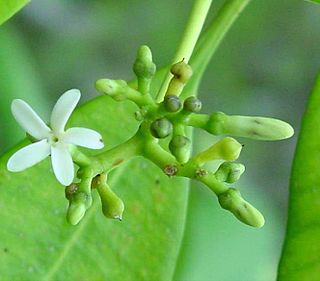
Ochrosia brownii, synonym Neisosperma brownii, is a species of plant in the family Apocynaceae. It was endemic to the Marquesas Islands in French Polynesia and is extinct in the wild.

Ochrosia thiollierei, synonym Neisosperma thiollierei, is a species of plant in the family Apocynaceae. It is endemic to New Caledonia. It is threatened by habitat loss.

Ochrosia borbonica is a species of plant in the family Apocynaceae. It is native to Mauritius and Réunion, and naturalized in Guangdong Province in China.

Ochrosia is a genus of flowering plants, first described in 1789. It is in the family Apocynaceae, native to Southeast Asia, Australia, and various islands of the Indian and Pacific Oceans.
- Ochrosia ackeringae(Teijsm. & Binn.) Miq. – Indonesia, Philippines, Papuasia, Christmas Island
- Ochrosia acuminataTrimen ex Valeton – Sulawesi
- Ochrosia alyxioidesGuillaumin – Vanuatu
- Ochrosia apoensisElmer – Luzon, Mindanao
- Ochrosia balansae(Guillaumin) Baill. ex Guillaumin – New Caledonia
- Ochrosia basistaminaHendrian – Sulawesi
- Ochrosia bodenheimarumGuillaumin – Vallée de la Toutouta in New Caledonia
- Ochrosia borbonicaJ.F.Gmel. – Mauritius + Réunion; naturalized in Guangdong
- Ochrosia brevitubaBoiteau – New Caledonia
- Ochrosia brownii(Fosberg & Sachet) Lorence & Butaud – Nuku Hiva in Marquesas
- Ochrosia citrodoraK.Schum. & Lauterb. – New Guinea
- Ochrosia coccinea(Teijsm. & Binn.) Miq. – Maluku, Sulawesi, New Guinea, Solomon Islands; naturalized in Guangdong
- Ochrosia comptaK.Schum., Hōlei – Hawaii
- Ochrosia ellipticaLabill. – Lord Howe Island, Queensland, New Caledonia, Vanuatu, Nauru; naturalized in Guangdong + Taiwan
- Ochrosia fatuhivensisFosberg & Sachet – Fatu Hiva in Marquesas but extinct
- Ochrosia ficifolia(S.Moore) Markgr. – New Guinea
- Ochrosia glomerata(Blume) F.Muell. – Borneo, Sulawesi, Philippines, Maluku, New Guinea, Solomon Islands
- Ochrosia grandifloraBoit. – New Caledonia
- Ochrosia haleakalaeH.St.John, Hōlei – Maui + island of Hawaiʻi in Hawaiian Islands
- Ochrosia hexandraKoidz. – Kazan-retto
- Ochrosia inventorumL.Allorge – New Caledonia
- Ochrosia iwasakiana(Koidz.) Koidz. ex Masam.
- Ochrosia kauaiensisH.St.John, Hōlei – Kauaʻi in Hawaiian Islands
- †Ochrosia kilaueaensisH.St.John, Hōlei – island of Hawaiʻi in Hawaiian Islands, but extinct
- Ochrosia kilneriF.Muell. – Queensland
- Ochrosia lifuanaGuillaumin – Loyalty Islands + Isle of Pines in New Caledonia
- Ochrosia mariannensisA.DC. – Mariana Islands
- Ochrosia mianaBaill. ex Guillaumin – New Caledonia
- Ochrosia minima(Markgr.) Fosberg & Boiteau – Queensland, Papua New Guinea
- Ochrosia moorei(F.Muell.) F.Muell. ex Benth. – Queensland, New South Wales
- Ochrosia mulsantiiMontrouz. – New Caledonia
- Ochrosia nakaiana(Koidz.) Koidz. ex H.Hara – Ogasawara-shoto
- Ochrosia newellianaF.M.Bailey – Queensland
- Ochrosia novocaledonicaDäniker – New Caledonia
- Ochrosia oppositifolia(Lam.) K.Schum. – Seychelles, Chagos Islands, Sri Lanka, Maldive Islands, Andaman & Nicobar Islands, Thailand, Vietnam, W Malaysia, Indonesia, Papuasia, Samoa, Tonga, Tuvalu, Vanuatu, Wallis & Futuna, French Polynesia, Line Islands, Micronesia
- Ochrosia poweriF.M.Bailey – Queensland, New South Wales
- Ochrosia sciadophyllaMarkgr – Bismarck Archipelago, Solomon Islands
- Ochrosia sevenetiiBoiteau – New Guinea
- Ochrosia silvaticaDäniker – New Caledonia
- Ochrosia solomonensis(Merr. & L.M.Perry) Fosberg & Boiteau – Solomon Islands
- Ochrosia syncarpaMarkgr. – Bali, Lombok, Timor, Flores
- Ochrosia tahitensisLaness. ex Pichon – Tahiti
- Ochrosia tenimberensisMarkgr. – Tanimbar Islands
- Ochrosia nukuhivensisFosberg & Sachet = Rauvolfia nukuhivensis(Fosberg & Sachet) Lorence & Butaud
- Ochrosia sandwicensisA.DC. = Rauvolfia sandwicensisA.DC.
- Ochrosia tuberculata(Vahl) Pichon = Rauvolfia sandwicensisA.DC.

Ochrosia fatuhivensis is a species of plant in the family Apocynaceae. It is endemic to Fatu Hiva in Marquesas Islands of French Polynesia.
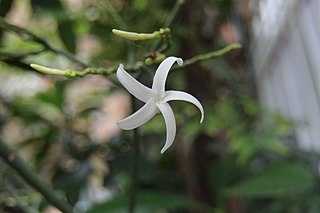
Ochrosia grandiflora is a species of plant in the family Apocynaceae. It is endemic to New Caledonia. It is threatened by habitat loss.
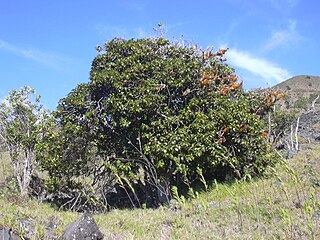
Ochrosia haleakalae, the island yellowwood or hōlei, is a species of plant in the family Apocynaceae that is endemic to Hawaiʻi. It is threatened by habitat loss.

Ochrosia kauaiensis, the Kauai yellowwood, is a species of plant in the family Apocynaceae. It is endemic to the island of Kauai in Hawaii. It is threatened by habitat loss.
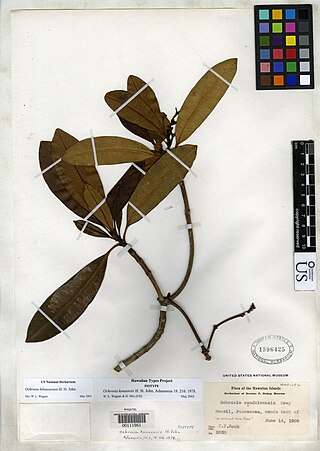
Ochrosia kilaueaensis is an extinct species of flowering plant in the genus Ochrosia in Apocynaceae. Its common names include holei and Hawaii yellowwood. It was endemic to the island of Hawaiʻi. It has been collected only at Puuwaawaa and Kipuka Puaulu and has not been seen since the 1940s.

Ochrosia tahitensis was a species of plant in the family Apocynaceae. It is endemic to Tahiti of the Society Islands, in French Polynesia.
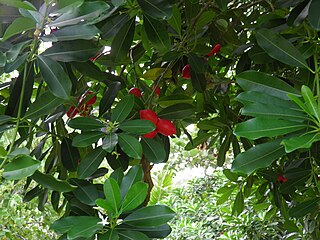
Ochrosia elliptica, commonly known as northern ochrosia, bloodhorn, scarlet wedge-apple, or simply ochrosia, is a tree in the dogbane family Apocynaceae native to north-eastern Australia and the southwest Pacific.
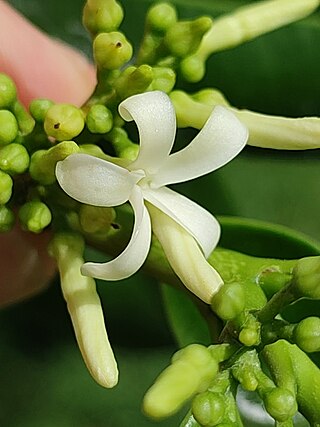
Ochrosia oppositifolia grows as a small to medium-sized tree up to 25 metres (82 ft) tall, with a trunk diameter of up to 50 centimetres (20 in). Its flowers feature a creamy to white corolla. Its habitat is coastal forest, bush or open areas to 100 metres (330 ft) altitude, rarely inland. Local medicinal uses include as a carminative and in high doses as an abortifacient. Ochrosia oppositifolia is native to regions from the Seychelles through tropical Asia to the Pacific.

Ochrosia glomerata is a species of tree in the family Apocynaceae.
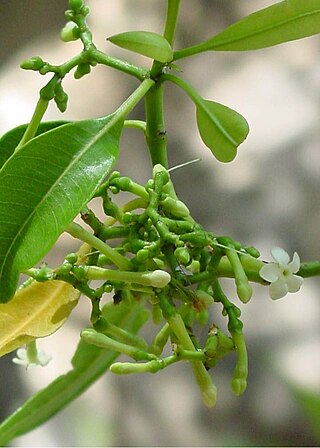
Rauvolfia nukuhivensis is a species of plant in the family Apocynaceae. It is endemic to Nuku Hiva in the Marquesas Islands in French Polynesia.

















